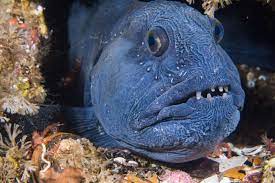In the frigid waters of the North Atlantic and Arctic oceans, an elusive predator roams, known as the Wolf Fish (Anarhichas lupus). With its powerful jaws and distinct appearance, the Wolf Fish has intrigued marine biologists and fishermen for centuries. In this blog, we will dive into the depths to explore the fascinating world of the Wolf Fish and uncover the secrets of this formidable creature.
- A Predator of the Cold Waters:
The Wolf Fish is a cold-water species found primarily in the North Atlantic and Arctic regions. It inhabits rocky coastal areas and can also be found in depths of up to 500 meters. The cold waters are crucial for its survival, as it is highly adapted to these harsh conditions.
- Physical Characteristics:
The Wolf Fish is easily recognizable by its elongated, eel-like body, and its large, powerful jaws filled with sharp teeth. Its teeth continue to grow throughout its life, making them effective tools for crushing the shells of its prey. The fish’s coloration varies from dark green to brown, helping it blend into its rocky surroundings.
- Feeding Habits:
As a voracious predator, the Wolf Fish has a diverse diet. Its primary prey includes crustaceans, mollusks, and other small fish. The strong jaws and teeth of the Wolf Fish allow it to crush the hard shells of its prey effortlessly. This makes it a formidable predator in its cold-water habitat.
- Unique Adaptations:
The Wolf Fish possesses several remarkable adaptations that enable it to survive in its harsh environment. Its specialized teeth and jaw structure are a result of its diet, while its elongated body shape helps it maneuver through tight spaces in the rocky reefs it calls home.
- Reproduction and Parental Care:
The reproductive behavior of the Wolf Fish is fascinating. During the breeding season, males create nests in rocky crevices where females lay their eggs. Males diligently guard the eggs until they hatch, displaying remarkable parental care uncommon among fish species.
- Threats and Conservation:
The Wolf Fish is not commonly targeted by commercial fisheries, but it often becomes entangled as bycatch. Overfishing and habitat destruction in its coastal habitats can pose threats to its population. Although the species is not currently considered endangered, ongoing monitoring and conservation efforts are essential to ensure its long-term survival.
- Ecological Importance:
As an apex predator, the Wolf Fish plays a vital role in the ecological balance of its habitat. By controlling the populations of its prey, it helps maintain the health and diversity of the underwater ecosystems it inhabits.
- Folklore and Cultural Significance:
The Wolf Fish holds cultural significance in regions where it is found. In some indigenous cultures, it is regarded as a symbol of strength and survival. Additionally, the Wolf Fish has been featured in local myths and stories, further contributing to its enigmatic reputation.
Conclusion:
The Wolf Fish remains a creature of mystery in the cold waters it inhabits. Its unique physical characteristics, feeding habits, and reproductive behavior make it a fascinating subject of study for marine biologists. As we continue to explore the depths of our oceans, understanding and protecting the Wolf Fish and its delicate habitat are crucial for maintaining the biodiversity and ecological balance of our marine ecosystems.




















Add Comment